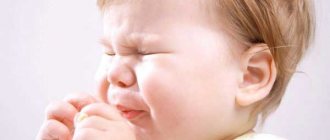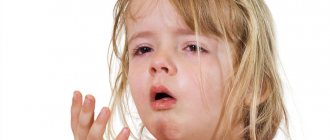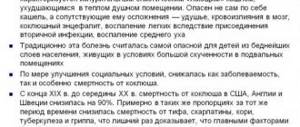What does it mean to have a cough and runny nose in a baby without fever?
A cough in an infant is a symptom that can indicate a variety of diseases. If a cough occurs along with a rise in temperature and a runny nose, then these are clear signs of a cold. But when the cough is not accompanied by an increase in temperature, the situation is more complicated, because it is sometimes difficult to understand the cause of such a symptom. However, treatment should begin as soon as symptoms are detected.
Causes and treatment of cough
Cough without fever can be of three types: dry, wet and barking. Each of them has its own symptoms and risk factors.
Barking
In infants, the muscles are not yet fully formed. For this reason, very often they suffer from the so-called “barking” cough. It is so called because it is very similar to the barking of a dog. The symptom may be severe and accompanied by wheezing and whistling. If the cough occurs very often, then the baby is simply exhausted.
The result of the pathological process is the formation of severe hoarseness, during which the baby may even lose his voice.
The main reasons for the formation of a barking cough are the following:
- diphtheria or whooping cough;
- laryngitis, pharyngitis;
- bronchial asthma;
- indoor air is too dry;
- presence of a foreign object in the throat;
- cyst in the larynx;
- allergy;
- infectious diseases.
Dry
This symptom is characterized by the absence of copious sputum discharge. The cough can take on a strong, hysterical character, accompanied by painful sensations. The formation of a non-productive cough without fever can be affected by a cold or damage to the ENT organs by infections.
At the initial stage of a cold, infants experience a sore throat and an unproductive cough. After a few days, the intensity of the symptoms decreases, the cough turns into a wet form, as the body begins to produce phlegm.
But then the cough again turns into a non-productive form, because mucus is released in smaller quantities. The most common causes of dry cough include:
- influenza virus;
- cigarette smoke, dry indoor air;
- pungent chemical odors.
So you should not ignore the fact that a dry cough that affects a baby many times throughout the day is a clear sign of laryngitis, an infectious disease, whooping cough, measles. Here we describe the treatment of a dry cough in an infant without fever.
Wet
If a small child is able to cough up sputum, then the cough is called productive. It received this name for the reason that the bronchi are cleansed of secretions. The reason for the formation of such a cough is the presence of acute respiratory infections, a common runny nose, allergies, pneumonia and bronchitis. If the sputum is released with a viscous consistency, then it is important to take care of its prompt evacuation. Otherwise, pathogenic microorganisms will multiply in it. This phenomenon causes serious complications.
With a wet cough, the secretion released may take on a cloudy hue, which indicates the beginning of the formation of an inflammatory process. If the mucus has a rusty tint, you can recognize an allergy, and the green color indicates sinusitis and tuberculosis.
Intense mucus secretion may indicate the development of bronchitis and tracheitis. If a productive cough is detected in a baby during treatment, this is a good indicator that the patient is recovering. Sputum discharge in such young children is difficult due to the fact that its viscosity is too high, and the muscles are not yet so well developed.
Treatment
Drug therapy involves the use of mucolytic drugs that have an expectorant and thinning effect. When taking synthetic expectorants, high productivity and rapid removal of viscous mucus are achieved.
Herbal medicines are considered excellent antitussive drugs, but before taking them you need to make sure that your baby is not allergic. During therapy, it is necessary to fill the room with fresh air. The baby should not be in the room during ventilation.
Provide your baby with plenty of fluids by preparing tea, fruit juice, decoction and mineral water. You can also get a positive effect by drinking warm milk and radish juice.
Since the formation of cough is influenced by various factors, there are also medications aimed at eliminating it . Their selection should be carried out by a pediatrician after a thorough examination of the patient. Treatment will give a positive result only if parents strictly follow all recommendations. Only safe and appropriate therapy will lead to a successful outcome. Sometimes a baby develops a cough when teething.
Causes and treatment of runny nose
In babies under one year of age, an infrequent cough without fever is considered a completely normal symptom. Thus, their airways are cleared of dust and mucus that has entered the trachea and bronchi. As a rule, this is a cough in a baby in the morning or after eating. But sometimes parents notice a symptom in their children such as a runny nose or snot without fever. It occurs very often after walking outside in cold weather. The reason is the temperature difference. It goes away as suddenly as it appeared. But there are situations when a runny nose causes a certain illness.
In the video, a baby has a cough and runny nose without fever:
Very often, a runny nose without fever in young children is the result of a cold that occurs when the respiratory system is infected by viruses. The child’s immunity enters into a fight with it and actively eliminates them. This is what explains the lack of temperature.
The next cause of a runny nose without fever is an allergic reaction. The symptoms of allergic rhinitis are very similar to the symptoms of a cold, but have certain differences:
- nonproductive cough;
- swelling of the nasal mucosa, discharge from the nasal cavity;
- increased lacrimation;
- the skin turns red and a rash forms on it.
Regardless of what caused the runny nose - a cold or an allergy - treatment must necessarily involve humidifying the air in the room. Ventilate the room in which the baby is located more often, or use a special humidifier for this purpose. Water in bowls that need to be placed throughout the room also combats dry air.
Be sure to give your child as much fluid as possible. It is the liquid that promotes the rapid evacuation of toxins, thinning viscous mucus in the nose and rapid cleansing. Plain water or special children's teas are suitable for these purposes. Chamomile decoction has proven itself well.
The nasal cavity should be washed as often as possible with a solution based on sea water or table salt. There is a small spoonful of salt per glass of warm water. To get the maximum effect, you should add a few drops of iodine.
You can use pharmaceutical products to cleanse your nose. The following are in great demand here:
- Aqualor,
- Aquamaris (here you can read reviews of nasal drops for children Aqua Maris),
- Salin.
Thanks to them, it is possible to moisturize the nasal mucosa and the internal cavity of the nasopharynx. The presented medications have an antiseptic and bactericidal effect.
To combat nasal congestion, parents can use vasoconstrictor drops.
The following can help with this:
- Nazol Baby,
- Nazivin for newborns.
If the baby’s nose is not very clogged during the day, then drips of vasoconstrictor drugs should only be used at night. These medications can be used for no more than 7 days.
Read how to treat a runny nose with a nebulizer in children.
Here we describe the treatment of a wheezing cough in a child.
Reviews about using an inhaler for coughs and runny nose: https://prolor.ru/g/lechenie/ingalyator-ot-kashlya-nasmorka.html.
Causes and treatment of bronchitis
Inflammation of the bronchi can be caused by damage to them by viruses and bacteria. The most common pathogens that can cause pathology are:
- influenza virus;
- adenoviral infection;
- parainfluenza;
- rhinovirus infection;
- chlamydia and mycoplasma;
- pneumococci, staphylococci and streptococci.
All these microorganisms can infect the baby's body through airborne droplets from carriers of the infection. People who have this disease and are close to the baby can act as carriers.
With this illness without fever, it is important to provide the baby with proper care, regimen and nutrition. Regardless of the form of bronchitis, it is important that the patient consumes dairy products, as well as products of plant origin. Give your baby a variety of drinks. Monitor the air humidity in the room and ventilate the room often.
The video talks about the treatment of bronchitis in a newborn without fever:
Make sure your baby breathes through his nose. To make breathing easier for him, you need to rinse your nose with a solution based on sea salt and use vasoconstrictor drops. The most effective are Tizin, Galazolin, Farmazolin. If a child has allergies, then it is worth using antiallergic drops in the therapeutic process. But you shouldn’t use it for a long time, otherwise the nasal mucosa will be damaged.
When fighting a cough, the doctor may prescribe antitussive drugs - Sinekod. But it is advisable to use them for debilitating cough. When the baby loses mucus, he needs to use expectorants - Althea, Licorice, Thermopsis. To eliminate the viscosity of sputum, you can use mucolytics - Ambroxol, Chymotrypsin, Bromhexine. It is best to use these medications by inhalation. When a child’s cough is accompanied by bronchospasm, he needs to use bronchodilators - Atrovent, Erespal.
Komarovsky's opinion
Komarovsky strongly recommends that all parents consult a doctor immediately after the appearance of symptoms such as cough and runny nose without fever. Sometimes such signs can hide a dangerous disease. At home, the baby needs to rinse the nose, give as much fluid as possible, and humidify the air. Such seemingly simple measures will quickly alleviate the patient’s condition and eliminate unpleasant symptoms.
In the video, Komarovsky talks about a wet cough in a baby without fever:
A runny nose and cough without fever in infants can occur for a variety of reasons. The success of treatment will directly depend on how accurately the cause of the pathology was determined. Parents should simply follow all the recommendations and surround their child with attention and care. Here you can read about the treatment of mucus in the nasopharynx in infants.
ProLor.ru
Features of the treatment of cough in infants
When an infant starts coughing, this is a serious reason to call a doctor. The reason is that the body of such a baby is still very delicate, and metabolic processes occur at an accelerated rate. It is very important not to waste time, otherwise the inflammatory process will move into an acute state. Before you begin treating a cough in an infant, it is worth determining its cause. Only then can you get rid of not only the cough itself, but also the illness that caused it.
How cough is treated in children with adenoids can be found in this article.
Basic methods
Therapeutic measures to eliminate dry cough in infants are somewhat different from the treatment of older children. Before the doctor arrives, it is necessary to monitor your body temperature, because the main cause of cough is ARVI or acute respiratory infections.
When the doctor prescribes the necessary treatment regimen, parents should be patient, since such diseases do not go away in two.
How to treat when a child develops an allergic cough can be found in this article.
Medicines
Mucolytic agents are a salvation for dry cough in such young patients. But achieving maximum effect is only possible with complex therapy. Dry cough can be combated with Bronchicum syrup. Gedelix, dry mixture, Bronholitin also have a positive effect. They are ideal means for treating a baby from the first days of life. Before using medications, you should always consult your doctor.
How to treat a wet cough in a child can be found in this article.
Compresses
The use of ointments and compresses is possible when there is a rise in body temperature. Mustard plasters are considered the best remedy to combat the disease. But the time of their exposure should not be too long, since infants have very delicate skin. After removing the mustard plasters, the baby should put on warm clothes. You can also use Vishnevsky ointment for a compress.
You can learn how to treat dry cough in a child using inhalation from this article.
Ointments
To combat dry cough, your doctor may prescribe ointments such as Doctor Mom and Bom Benge. Before rubbing your baby, you should apply the ointment to a small area of skin. This way you can check for the presence or absence of allergies. If there are no suspicious symptoms and there is no redness, then you can use a rubbing ointment. Use this treatment until all manifestations of the disease pass. During rubbing, it is possible to transform a dry cough into a wet (wet) one and achieve complete recovery.
Treatment in the absence of fever
When an infant (1, 2, 3, 4, 5 months and older) has a cough but no fever, antibiotics should not be used. For such cases, the ideal solution would be to take syrups. They help improve reproduction and sputum production. In addition, there are certain medications for the respiratory system that have a combined effect. It lies in the fact that all the forces of the cough fade over time, and the accumulated sputum is actively released.
From this article you can learn how to quickly cure a runny nose and cough.
If a doctor prescribes expectorant and antitussive medications separately, it is prohibited to take them at the same time. Such actions will lead to various consequences that will provoke serious pathology. As a rule, the medications presented cause severe overload in the liver and kidneys.
Herbal mixtures of medicinal herbs are very active in combating cough in infants without fever. But their intake and dosage must be prescribed by a doctor, otherwise you may get the opposite effect. Inhalations with Borjomi and chamomile, which should be carried out using a nebulizer, are excellent.
The article indicates whether cough occurs with thyroid disease.
If we talk about the specific names of mucolytic drugs, then most often doctors prescribe to infants:
- Mukolik;
- overslept;
- Tussamag;
- Dr. Theiss;
- Gerbion.
They often have a pleasant fruity taste, so the baby will really like it, and also saturate his body with useful vitamins.
Traditional methods
Traditional methods of treatment also have an excellent effect on coughing in infants. But they should be used very carefully so as not to harm the baby. For example, you should not warm up with mustard plasters when the baby has a fever.
How to treat a severe cough during pregnancy can be found in the article.
Onion jam
This medicine effectively copes with the disease in children up to 2 months old, and it can be done very quickly. To prepare, you need to grate the onion and add honey in a 1:1 ratio. wait 1.5 hours until the composition is infused, express the juice and give the baby a dessert spoon every hour.
Coltsfoot and plantain
This medicinal herb is acceptable from 4 months of age. A decoction prepared from these components is used as a medicine. To prepare it, you need to take a spoonful of coltsfoot and plantain, pour them into a thermos, add 500 ml of boiling water. Leave for 2 hours. The baby can take 2 spoons 15 minutes before meals. This medicine has an expectorant effect. If you find that after taking the composition the child develops a gag reflex, then you should reduce the dosage.
Licorice, elecampane and marshmallow
Licorice root has a positive effect during the treatment of cough. The maximum effect can be achieved by combining licorice, elecampane and marshmallow. Take the presented components in equal proportions. There are 2 cups of boiling water per tablespoon of the mixture. Leave for 8 hours. Take the received medicine 50 ml 2-3 times a day for the baby.
Why coughing and vomiting occurs after eating can be found in this article.
Compresses
Warm compresses can be used to speed up the healing process. They are represented by the following recipes:
- From honey. Knead honey cake using honey, sunflower oil and flour. The resulting cake should have a dense consistency so that after it is placed on the chest, it will not spread anywhere. Some mothers add mustard powder during the cooking process. But it is not always appropriate to do this, since the baby’s skin is very delicate and this can provoke an allergic reaction. Mustard can be used by children over 4 months of age.
- Apply a compress of camphor oil.
- To warm up, use a potato compress.
- Badger fat, insulated in gauze compresses, is suitable for rubbing.
To get the desired effect from the compress, you should know the sequence of actions when performing it:
- Fold the sheet in several layers.
- Place the medicinal composition.
- Place another sheet on top.
- A layer of polyethylene.
- Secure everything with gauze.
How dry cough is treated with folk remedies can be found in this article.
The video talks about treating cough in infants with folk remedies:
Inhalations
To alleviate the condition of a small patient and eliminate a dry cough, it is worth using passive inhalations. To implement them, you need to fill the bath with boiling water and wait for the room to warm up with steam. The baby is brought into this room so that he can breathe in the vapor for 5 minutes. If you are not allergic to eucalyptus essential oil, you can add a few drops to the water.
Massage
In addition to all the treatment options presented, massage has an excellent effect in treating cough in infants. It should be based on gentle patting and tapping. The treatment area is the baby's chest and feet. The maximum effect can be achieved by using herbal balms. Such measures can improve the process of sputum discharge.
Treatment according to Komarovsky
The famous children's doctor Komarovsky suggests that parents use such harmless and effective remedies as Mucaltin, Potassium Iodide, Bromhexine, Lazolvan to treat cough in infants. These drugs should always be in your home medicine cabinet. Only a doctor can determine the required dosage and the need for their use, taking into account the specific case.
The best remedy for smoker's cough is indicated in the article.
In the video, Dr. Komarovsky talks about a baby’s cough and its treatment:
If parents try to overcome a cough on their own, then this is not only a pointless, but also a dangerous hobby. If you constantly change medications that do not have an immediate effect, then this is very unwise.
At first, it is very important to simply determine the cause that provoked the cough. Perhaps there is a plant in the room, a woolen carpet, or the air is too dry. All these factors greatly influence the formation of the presented symptom.
Sometimes it’s enough just to let your baby breathe some fresh air, and the cough will go away. After all, this symptom is considered the result of the body’s attempts to eliminate dry mucus residues in the nasopharynx. Therapy aimed at eliminating only one cough is a kind of cosmetic repair, since over time this symptom will make itself felt again, because the true cause of its formation has not been eliminated.
The body of infants is not yet so strong and strong. Very often it can be affected by a variety of diseases, the symptom of which is a cough. To treat this condition, it is necessary to first determine the cause of the symptom, and only then carry out effective therapy as prescribed by the doctor.
ProLor.ru
Medicines for treating cough
Lazolvan is a good remedy against wet cough for children. It is available in the form of syrup for internal use and solution for oral administration and inhalation. By the way, according to E.O. Komarovsky inhalation with a nebulizer can be carried out exclusively to combat diseases of the lower respiratory tract and only as prescribed by the attending physician.
Modern synthetic mucolytics are taken on the 3rd-4th day of illness, provided that the cough has not become wet and sputum separation is difficult. For bronchitis and pneumonia, specialists usually prescribe ACC, Lazolvan (Ambrobene), Bromhexine. Some of these remedies can be used if an infant has a cough. However, it is still not worth treating a child’s cough with or without phlegm on your own.
Mucopront, Bronkatar, Mucodin are well-known mucoregulators. They not only thin out mucus, but also normalize the activity of cells in the bronchial mucosa. A significant disadvantage of treatment with these medications is the likelihood of constipation in the patient. Therefore, they should only be taken under the supervision of a specialist.
Separately, it is worth mentioning about antitussives, for example, Sinekod, Tusuprex. Their use is justified only when the baby is bothered by a dry and painful cough, leading to vomiting and chest pain, appetite and sleep disturbances, for example, with whooping cough. Self-use of these medications can worsen the situation. They can only be prescribed by the attending physician.
So, if there is sputum in the child’s respiratory tract, and the parents give him antitussives (and in the worst case scenario, also with expectorants and mucolytics), then he simply will not be able to cough up, and the sputum will stagnate in the respiratory tract, which is likely to cause complications.
A respiratory infection is almost always accompanied by an inflammatory process, so doctors often prescribe Erespal to children, which indirectly helps to expectorate mucus. Drugs that expand the lumen of the bronchi (bronchodilators) are: Ventolin (Salbutamol), Berodual, Eufillin.
How to treat a cough in a baby?
Children in the first year of life who are breastfed usually have good immunity and very rarely get colds. But bottle-fed and premature babies often get sick. Factors that further reduce immunity include rickets, insufficient or excessive weight gain in the child, poor care, rare exposure to fresh air, and heredity.
Treatment of cough in infants: features
The main reasons for coughing in infants:
- ARVI, the most common symptoms of which are cough, runny nose and fever.
- Inflammatory diseases of the upper respiratory tract, which are bacterial complications of acute respiratory viral infections and are also manifested by coughing.
- Polluted air indoors or outdoors, too dry air in the child’s room.
- A reflex cough that occurs when a foreign body enters the upper respiratory tract. It appears against the background of complete health during meals, especially when eating nuts or dry cookies, as well as when the child plays with a severe coughing attack. Occurs with inflammation of the middle ear due to irritation of the eardrum.
Treatment of cough in children under one year of age depends not only on the causes of the cough, but also on the type of cough. There are the following types:
- dry, unproductive (without sputum production) and wet, productive (with sputum production);
- acute (up to 3 weeks) and chronic;
- constant and short-term, as well as episodic and paroxysmal.
How to treat a cough in an infant?
In infants, treatment of cough, especially with home methods, is possible only in the absence of elevated body temperature. If the temperature is elevated, then treatment of cough in infants is carried out only in the hospital under the supervision of a doctor.
If we are treating a cough without fever in a newborn, then first of all we must take care of the microclimate in the room where the child is. The room must be regularly ventilated - at least 2 times a day, the temperature should be 20-22 degrees, and to increase the air humidity in the room, you can hang a wet diaper or place open containers with water.
To improve coughing, the child is given a light massage of the chest and abdomen. To reduce intoxication and to prevent dehydration, the child is given a sufficient amount of liquid to drink. Fresh air will be very beneficial for a child with a cough, so you should not avoid walking outside and it is recommended to put your baby to bed on a well-ventilated veranda for a nap, but only at normal body temperature. If a child has a dry cough, it needs to be made moist, for which compresses are often used.
Medicines for the treatment of cough in the first year of life
For dry cough, drugs are used that suppress cough only when it becomes paroxysmal and risks becoming a harbinger of bronchospasm.
Along with them, antiallergic drugs (Diazolin) are prescribed, and, if necessary, hormonal injections.
If the cough is wet, then to facilitate the removal of sputum, they use means to thin it out (Lazolvan, Ambroxol) in children after 3 years of age, as well as sprays, and to remove phlegm they use special massage techniques, teas with chamomile and coltsfoot, compresses and rubbing chest with eucalyptus ointment, mustard plasters through several layers of gauze.
At high temperatures, the doctor prescribes antipyretic drugs. And in case of purulent inflammation, an injection course of broad-spectrum antibiotics (most often from the group of cephalosporins) can be added.
WomanAdvice.ru
Why does a wet cough occur?
It is very important not to miss the moment and contact a specialist in time to find out what causes a wet cough in an infant.
A productive cough is characterized by the production of thin sputum and mild coughing. But, as you already know, in young children (especially newborns and up to six months) the cough reflex is not sufficiently developed. Therefore, they simply do not cough up the mucus that forms.
If an adult child in this situation recovers quickly, since the lower respiratory tract will quickly clear, then a 2-4 month old baby has every opportunity to get a complication.
- Bronchiolitis
One of the most common reasons why children in the first year of life are hospitalized. With this disease, blockage of the bronchioles occurs. At the first stages, the cough may be wet, and later it becomes like a squeak. Bronchiolitis often becomes a complication of acute respiratory viral infections and colds in children of the first year of life.
- Sarcoidosis
Rarely diagnosed in newborns and infants. This disease can occur for a long time without any symptoms and is detected only during instrumental examination. Sarcoidosis cannot be contracted in everyday life; the causes of this pathology remain controversial to this day.
- Bronchitis
Inflammation of the bronchi. In the early stages, this disease is characterized by a dry cough, but with adequate therapy and proper organization of environmental conditions, it quickly turns into a wet cough.
A wet cough can also appear in a baby for physiological reasons, just like a dry cough. If a child coughs only in the morning, then this is probably how the respiratory system is cleared of mucus accumulation at night. This fact does not pose any danger.











